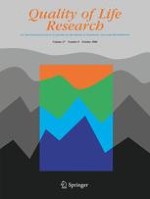01-10-2008
Health related quality of life in 10-year-old schoolchildren
Gepubliceerd in: Quality of Life Research | Uitgave 8/2008
Log in om toegang te krijgenAbstract
Objective
The purpose of this study was to investigate the health related quality of life (HRQL) in a total cohort of general school children.
Methods
The study population consisted of the children starting 4th grade (age 9–10) in Finnish primary schools in autumn 2004 (n = 1,346) and their parents in a city of 175,000 inhabitants. Pediatric Quality of Life Inventory™ 4.0 (PedsQL™ 4.0) was used for assessment of HRQL. The response rate was 81% for the children (n = 1,091). Most children had parents who participated (n = 999).
Results
The children reported highest HRQL mean values in physical (85.00, SD 10.95) and social (84.71, SD 14.28), and lowest in school (78.89, SD 14.53) and emotional (75.43, SD 15.67), functioning scales. Girls reported significantly lower emotional (t = −2.43, P = 0.02) functioning than boys. Child self reports show lower social (t = −2.57, P = 0.01) and school (t = −3.44, P = 0.0006) functioning, and higher emotional (t = 5.82, P < 0.0001) and physical (t = 4.79, P < 0.0001) functioning than their parent-proxy assessments.
Conclusions
Interventions aiming at supporting the emotional and school functioning of the school children are recommended. Parents may overestimate the social and school functioning and underestimate the physical and emotional functioning compared to their children’s own perceptions.
